Wood Street School 8th Grade Graduating Class
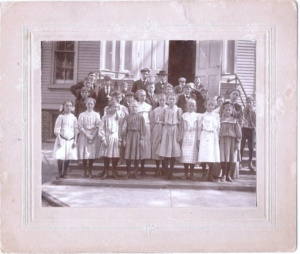
This is the 8th grade graduating class of Wood Street School in Palatine. Cora Foreman is the tallest girl in the center of the picture.

This is the 8th grade graduating class of Wood Street School in Palatine. Cora Foreman is the tallest girl in the center of the picture.
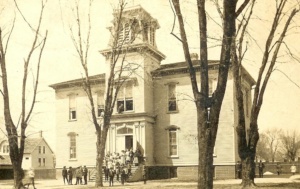 This four room wooden school was built in 1869 with four classrooms and a basement. It was built on land donated by Joel Wood. Palatine High School was started in one upstairs room here by principal Charles Cutting. It was torn down in 1912.
This four room wooden school was built in 1869 with four classrooms and a basement. It was built on land donated by Joel Wood. Palatine High School was started in one upstairs room here by principal Charles Cutting. It was torn down in 1912.
Bradwell School was built in 1851. The year prior school had been held in a rude shack. Ezekiel Cady helped build the new school and it was named for Judge Thomas Bradwell. After many years of service a straw vote was held in 1921 and School District No. 17 decided to tear down the “old brick school” and replace it with a modern building. John Bergman of Palatine was hired for its construction. It was considered to be a model for the new generation of school houses. The wood and stucco building featured a large classroom with new seats, slate blackboard, modern ventilation, furnace heat and improved inside chemical toilets. Teachers included Miss Kelley, Mrs. Ackerman and Esther Lindholm. The district voted to consolidate with other small districts into Community Consoldidated School District 15 in 1946. The school continued to be used until it was sold at auction in 1954. It is believed that the school was converted to a home still standing at Ela Rd. and Bradwell Rd.

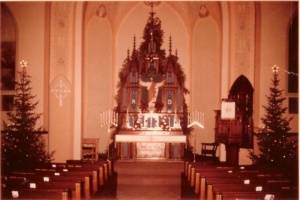
In 1869, eleven families met at the train depot to discuss the formation of a Lutheran congregation. Before that a minister from Schaumburg Township held services every other Sunday at the Masonic building at Wilson & Bothwell. A week later the membership was formally organized. Four acres were purchased on Greeley Street including the cemetery. The cemetery was formally dedicated and plans progressed for a church building on that site. Lack of funds held up the building of the church and eventually the land was sold to H. C. Batterman. With that money, a church building formerly used by the Disciple Church was bought on Plum Grove Road. A parsonage was built to the north of the church. In 1873, the congregation joined the Evangelical Lutheran Synod of Missouri. Services were held in German until after the turn of the century when English services were held once a month. Since 1943, all services are in English. The present church building was dedicated in 1970 and additions have since been built.
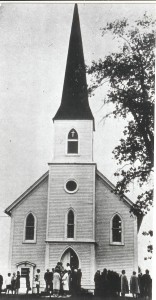
This is the present church of St. John’s built in 1885. It was the third building on these grounds. The first was built in 1846, replaced in 1876, burned down and rebuilt in 1885. In 1957 the name of the church became St. John United Church of Christ, a denomination formed from the merger of two church groups. Directly east of the church are early burials. Many early German settlers are buried here. East of the parsonage is the newest section of the cemetery called Mount Hope. Three acres of land west of the church were purchased and in 1969 St. John Garden Chapel was dedicated.
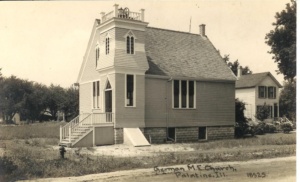
Circuit riders from DesPlaines held services among the early Plum Grove settlers. John Nordmeier donated land at Plum Grove and Kirchoff Roads to build a church. There is no record of when it was built but it was struck by lightning and burned in the early 1890’s. This church was built at the same location. In 1912, a lot was purchased at Plum Grove and Lincoln and the building was moved into town. The congregation became small and was disbanded in 1955. The building was sold to the Lutheran Church. The Salem Cemetery at Plum Grove and Kirchoff still exists on the land once belonging to this church.
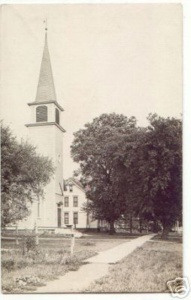
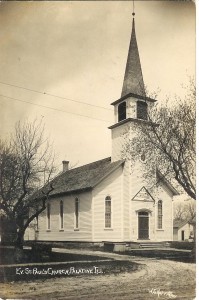
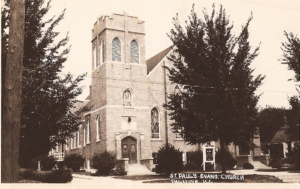 In 1870, many of the members of St. John’s Church had moved to the village of Palatine. In order to serve them better, mission work began. Services began being held at the old Masonic Hall. The next year, the congregation was organized and named the German United Evangelical St. Paul’s Congregation. The first church building was dedicated in 1872 and a parsonage was built on Palatine Road, then Chicago Avenue. The parsonage burned in 1897 and was replaced the same year. In 1925, a new brick building replaced the wooden one. An addition was added in 1955. Since 1957, the church’s name became St. Paul United Church of Christ. In 1971, the church celebrated its 100 years by remodeled the sanctuary and in 1985 a new entrance was added and remodeling was done to make the church handicapped accessible.
In 1870, many of the members of St. John’s Church had moved to the village of Palatine. In order to serve them better, mission work began. Services began being held at the old Masonic Hall. The next year, the congregation was organized and named the German United Evangelical St. Paul’s Congregation. The first church building was dedicated in 1872 and a parsonage was built on Palatine Road, then Chicago Avenue. The parsonage burned in 1897 and was replaced the same year. In 1925, a new brick building replaced the wooden one. An addition was added in 1955. Since 1957, the church’s name became St. Paul United Church of Christ. In 1971, the church celebrated its 100 years by remodeled the sanctuary and in 1985 a new entrance was added and remodeling was done to make the church handicapped accessible.
The worst Chicago & Northwestern freight train wreck in 50 years occurred Thursday, November 9, 1950. The aftermath above was captured on film by a local businessman. Twenty freight cars piled up in downtown Palatine. A total of 57 cars were smashed up or derailed. There were no casualties, but if a northbound passenger train had been on time, or if five gasoline tank cars had been full, the results would have been catastrophic. A steel beam from a gondola was driven into the ground about 18 feet. The National Guard and Red Cross rushed to the scene. Police had difficulty keeping curiosity-seekers out of harm’s way. A full description of the disaster is available on microfilm from the Palatine Enterprise issue of November 17, 1950. To see the video paste the following into YouTube’s address bar: f0dLNT5HSHo.
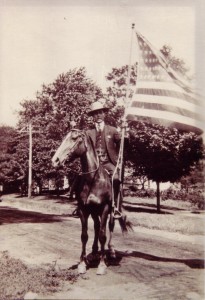
The Palatine Police Department considers Henry C. Schroeder as the first chief of police here. He was born in Palatine Township on his parents’ farm in 1883. He worked as a telephone company collector for 28 years. He was elected to the village Board of Trustees from 1910-1920 and from 1928-1934. At this time there was no organized police department here and only two paid policemen. This photograph from 1916 and a newspaper article from that year refer to him as police chief. He was chairman of the police and lighting committee on the Board. Since there are no records and no one was paid a salary, it is assumed that the chairman was the chief as well. His 1937 obituary says he served as police chief for many years. He married Gertrude Sigwalt and the couple had two children, Ralph and Vernette. Henry was also a volunteer fireman and a member of the Palatine Military Band.

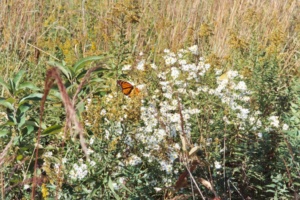
When the state of Illinois began selling land in this area for $1.25 an acre, around 1835, the settlers came and saw prairie and a few small groves of trees. What is prairie? It is grassland. A good part of Illinois was tall grass prairie then. It consisted of grasses like bluestem and many kinds of strong wild flowers like prairie smoke and Joe Pye-weed. Some of the flowers we now call weeds are really native plants such as goldenrod and Queen Anne’s lace. The grasses could be as high as ten feet and the soil they grew in was the richest in the country. That’s why farmers wanted to come here and grow crops like corn, wheat, and soy beans. Prairies were maintained by the animals that grazed on them like bison, elk, deer, and rabbits, and with prairie fires from lightning and native Americans about every five years. Prairie plants had deep roots and the fires traveled fast so they were not destroyed by these things, but quickly grew again. Land near the edges of the tree groves were settled first because wood was needed for building homes and for warmth and cooking. They had great difficulty plowing the dense prairie land. In 1837, that changed. John Deere invented the self-scouring steel bladed plow that could cut into prairie sod on a large scale. Within 50 years most of the prairie was converted to agriculture. Before settlement, 60% of Illinois was prairie; now less than 1% exists.
Where can you find prairie to visit today? Morton Arboretum and the Botanic Garden have sections of restored prairie. Spring Valley in Schaumburg Park District has a very nice section of prairie and also has Heritage Farm where you can see how early settlers lived and worked. There is a small piece of prairie thought to be original in Palatine. The Prairie Woods Audubon Society owns and takes care of it. The Palatine Prairie is near Quentin Road and Wood Street. It runs along the railroad tracks at the north end of the Reimer Reservoir. — Connie Rawa